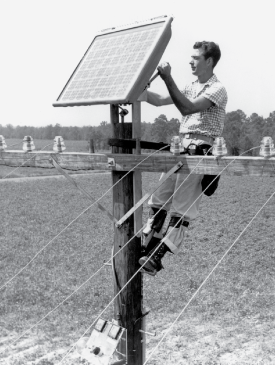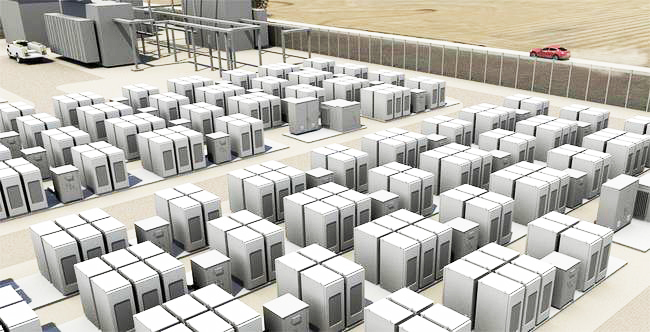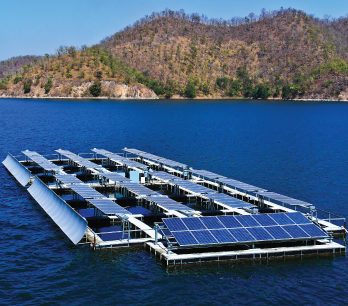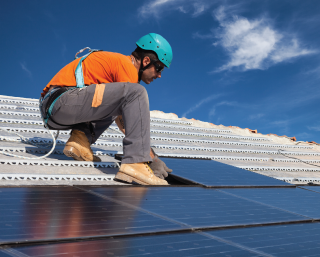The sun is the biggest source of energy in our solar system, and for thousands of years, human beings have exploited its energy to heat their homes, cook their meals, and produce hot water.
In ancient times, when heating a home wasn’t as simple as turning on the central air, civilizations such as the Egyptians and the Greeks had to plan months, if not years in advance to make their homes habitable during the winter.
Armed with their knowledge of the sun’s seasonal position in the sky, many homes were strategically built to capture as much of the sun’s heating rays as possible during the day so that they would stay relatively warm during the night.1
Many years later, in the late 19th century, we were still harnessing the sun’s energy with simple passive solar water heaters. Although these water heaters were nothing more than a simple black-painted barrel, they were still capable of storing hot water for extended periods of time by absorbing the sun’s heat during the day.

However, it wasn’t until 1954 that the world saw its first silicon solar panel. Created by Bell Labs, the technology represented a huge leap in humankind’s ability to harness the sun’s energy, and since then, the world has made tremendous progress in solar panel technology.
In fact, countries such as Germany receive more than half of their electricity from solar, which demonstrates that renewables such as solar are quite capable of supplanting traditional fuel sources when a concerted effort is made.
To help our readers learn more about solar energy, this article will discuss the current state of solar energy development, what the future of solar energy technology looks like, and how Landmark Dividend is helping solar developers get their projects off the ground.
The Current State of Solar
As it stands now, the world only gets about 1% of its energy resources from solar; however, it is entirely feasible that in the next 30 years this percentage could skyrocket to as high as 27%.2, 3
While it may seem farfetched, energy experts at the International Energy Agency (IEA) believe that such a dramatic increase is not out of the realm of possibility, especially as the current solar technology matures.
At 27%, solar energy systems such as solar farms and concentrating solar power (CSP) plants would become the world’s most valuable energy resource, generating more energy than fossil fuels, wind, or hydroelectric systems, as well as reducing carbon emissions by 6 billion tonnes per year.4
Solar Energy in the United States
As of 2017, the United States has approximately 1.3 million photovoltaic installations (PV), which amounts to 40 gigawatts (GW) of installed solar capacity—nearly twice the amount installed just a year ago.5
Why is solar growing so fast in the United States? For starters, government programs like the Investment Tax Credit (ITC) have helped incentivize solar development projects across the country, and with solar development costs falling at an average of 4.4% per year around the globe, solar development is showing no signs of slowing down.6
This growth has led to more than 260,000 Americans working in the solar industry, and more jobs are being created every year. As a matter of fact, more Americans were employed in solar power last year than coal, gas, and oil combined.7
Future Solar Technology
 Modern day solar panels have a maximum efficiency of about 33%, meaning that much of the sun’s solar radiation goes to waste even under the most ideal circumstances. This is a major obstacle that solar energy systems must overcome to achieve exponential growth in the energy industry.8
Modern day solar panels have a maximum efficiency of about 33%, meaning that much of the sun’s solar radiation goes to waste even under the most ideal circumstances. This is a major obstacle that solar energy systems must overcome to achieve exponential growth in the energy industry.8
Because of this inefficiency, the solar industry is investing heavily in finding new ways of improving the efficiency of solar energy systems, with 3 of the biggest developments being in solar energy storage, perovskites, and multi-junction cells.
Solar Energy Storage
A major obstacle to solar energy production comes in the form of solar energy storage.
Solar energy storage is crucial to the success of future energy systems because, without it, any excess electricity that is generated throughout the day cannot be utilized at a later time when sunlight isn’t as plentiful (like at night).
Energy storage allows solar energy plants to store excess energy so that it can be sold and used at a later time for a variety of reasons, including load leveling, emergency preparedness, and grid stabilization.
While these solar battery storage systems seem like a no-brainer, there is still much work to be done in bringing down the costs of these systems as they primarily consist of expensive lithium-ion batteries.
As costs go down and efficiency goes up, we should start to see battery storage installations become more commonplace in the future.
What are Perovskites?
Since the creation of the first solar panels in 1954, silicon has been the primary material used in solar cells. However, since silicon panels are intrinsically inefficient at creating usable energy, researchers have been looking into alternative materials, like Perovskites, to replace current silicon technology.
Perovskite (CaTIO3) is a naturally occurring mineral that displays a wide variety of useful properties, the most important one of which is superconductivity. Interestingly, the term “perovskites” also refers to a family of synthetic materials created to mimic the orthorhombic crystal structure found in the naturally occurring mineral, and because perovskites can be synthetically produced, they hold the potential to be both cheaper to produce and easier to work with than silicon.
In the past 7 years alone, solar cells created with perovskites have gone from an efficiency rating of just 3.8% to 20.1%. This rate of progress is promising to researchers and developers alike, as lowering the cost of solar panels is a key step to achieving exponential growth in the industry.
However, there are some technical hurdles to overcome with panels made out of perovskites, as perovskites decompose far too quickly to be implemented in real world applications.
If this technical hurdle can be solved, and if perovskite panel efficiency can surpass silicon panel efficiency, then the solar market will undoubtedly make the switch, resulting in even more growth and a greater variety in solar energy production.9
Multi-Junction Cells
While the industry waits for silicon alternatives, solar developers are pursuing other methods of increasing panel efficiency, one of which is the creation of multi-junction cells.
Multi-junction cells are essentially regular PV panels but with added layers to increase efficiency.
Each layer of a multi-junction cell is optimized to a particular wavelength, effectively increasing the efficiency of the panel to rates as high as 40%. When these multi-junction cells are used in an array, the amount of total electricity that can be generated from them (compared to traditional panels) increases exponentially.
However, the extra materials and engineering required to bring these panels to operating capacity means that they are far more expensive than traditional panels. Because of this price difference, and depending on the location, solar developers still may opt to use traditional solar panels instead.10
Solar Energy becomes Ubiquitous
Be it atop of a parking structure or along the freeway on the way to Las Vegas, solar installations are becoming more and more common every day.
Advancements in solar energy technologies have opened the door to a variety of different implementation scenarios, and the below are a couple of the most interesting developments we’ve seen thus far.
Floating Solar Farms

If you were asked to describe the location of a typical solar installation, you would probably describe a rooftop of some sort, or maybe a cornfield in the Midwest that has been converted into a modern day solar farm.
What probably doesn’t come to mind is a whole bunch of panels floating in the ocean; however, in China, that’s exactly what’s happening.
In June of 2017, China flipped the switch on the world’s largest floating solar farm, capable of producing 40 megawatts of power and powering up to 15,000 homes.
While it seems like an odd idea, building a solar farm in this manner allows the panels to be cooled by the ocean water, while at the same time, protecting existing land-based agricultural and terrestrial ecosystems from re-development.
This sort of solar installation would be especially beneficial for smaller nations that lack adequate land for the large, utility-scale solar farms, as they could now turn to the open ocean for their energy production needs.11
The Future of Solar Panels: The Tesla Solar Roof
While rooftop solar installations can reduce one’s energy bill, they’re also a bit unsightly to those who really care about the outward appearance of their home.
However, companies such as Tesla are working on future solar panels that are more aesthetically pleasing, and have now nearly reached the point where you can’t even tell that there are any solar panels installed at all.
Tesla’s “solar roof” is comprised of PV panels that look just like any other panel that might be used on the roof of a home, but provides the added benefit of solar energy generation.
This technology, in combination with home energy storage, is a perfect example of how solar energy is becoming literally “built-in” and more a part of our world than ever before.
With further advancements and creative thinking in future solar energy projects, it might not be long before the vast majority of our surfaces are generating electricity.
Opportunity for Landowners & Developers
 As demand for new solar installations continues to rise, landowners and developers have many more opportunities for generating additional income than ever before.
As demand for new solar installations continues to rise, landowners and developers have many more opportunities for generating additional income than ever before.
For landowners who own considerable amounts of property, it’s not out of the realm of possibility to be approached by a solar developer looking to enter into some sort of solar lease agreement.
Such an agreement would grant the developer the necessary rights to construct a solar installation on the property, and in exchange, the landowner would receive a monthly rental fee.
Depending on varying circumstances, this rental fee can be quite substantial, equating to thousands if not hundreds of thousands of dollars in annual rental payments.
And, because of the increased efficiency of solar panels and falling prices of various solar technologies, developers are seeing a faster return on their investment than ever before, making solar energy a very lucrative financial asset.
Landmark Dividend’s Role
Landmark Dividend is one of the nation’s largest and most successful ground lease acquisition companies, helping both developers and landowners to discover new avenues for generating wealth.
If you’re a landowner who is currently signed onto a solar land lease, we may be able to provide you with a large, lump sum payment for the entire value of your agreement. Likewise, if you’re a developer looking to purchase land for the development of a solar installation, we may be able to help get your project off the ground.
Please click here to submit your information so that we may contact you.
1. https://oilprice.com/Alternative-Energy/Solar-Energy/Could-Solar-Provide-27-Of-Worlds-Energy-By-2050.html
2. https://cleantechnica.com/2015/06/12/solar-power-passes-1-global-threshold/
3. https://oilprice.com/Alternative-Energy/Solar-Energy/Could-Solar-Provide-27-Of-Worlds-Energy-By-2050.html
4. https://www.betterworldsolutions.eu/the-sun-will-be-the-worlds-leading-power-in-2050/
5. https://www.seia.org/news/us-solar-market-grows-95-2016-smashes-records
6. https://www.greentechmedia.com/articles/read/solar-costs-are-hitting-jaw-dropping-lows-in-every-region-of-the-world#gs.RqdkbVQ
7. https://money.cnn.com/2017/05/24/news/economy/solar-jobs-us-coal/index.html
8. https://arstechnica.com/science/2017/02/for-a-brighter-future-science-looks-to-re-energize-the-common-solar-cell/
9. https://arstechnica.com/science/2017/02/for-a-brighter-future-science-looks-to-re-energize-the-common-solar-cell/
10. https://arstechnica.com/science/2017/02/for-a-brighter-future-science-looks-to-re-energize-the-common-solar-cell/
11. https://www.smithsonianmag.com/smart-news/china-launches-largest-floating-solar-farm-180963587/

